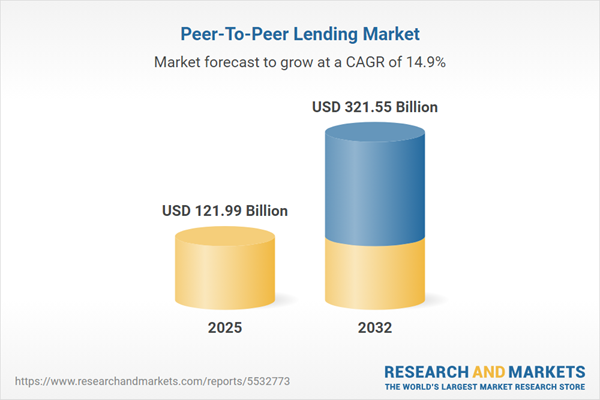Speak directly to the analyst to clarify any post sales queries you may have.
Peer-to-peer lending is transforming the way organizations manage capital flow and risk, providing senior executives with crucial tools to enhance financial agility, ensure regulatory compliance, and keep pace with rapid digital change.
Market Snapshot: Peer-to-Peer Lending Market
The global peer-to-peer lending market is entering a new development phase. In 2024, the market has reached a valuation of USD 106.18 billion. Looking ahead, projections forecast growth to USD 121.99 billion by 2025 and to USD 321.55 billion by 2032, reflecting a robust compound annual growth rate of 14.85%. This momentum is being driven by increased adoption of fintech solutions, broader use of digital lending platforms, and significant changes within worldwide regulatory frameworks. Senior financial leaders are responding by prioritizing dynamic risk management approaches, reevaluating compliance protocols, and realigning services to maintain relevance in this evolving environment.
Scope & Segmentation Analysis
This report delivers segmentation and strategic insights that support C-level executives in optimizing efficiency, mitigating risk, and strengthening competitive positioning within the peer-to-peer lending space. The analysis allows for focused evaluation of market potential across the following areas:
- Lending Types: Business loans, personal financing, and real estate lending, each suited for specific enterprise and individual financial needs.
- Funding Models: Auction-based platforms and fixed-rate systems, providing flexibility for customized risk and return strategies.
- Loan Terms: Options covering short, medium, and long-term borrowing support tailored liquidity management across diverse organizational strategies.
- Investor Types: Participation from both institutional and retail investors facilitates scalability and diversifies risk exposure.
- Loan Purposes: Financing for business growth, debt management, education, and healthcare highlights adaptability to shifting sector demands.
- Geographical Coverage: Analysis spans Americas, Europe, Middle East, Africa, and Asia-Pacific. U.S., Germany, China, and Australia receive additional focus, with particular attention to local regulation and digital adoption influencing cross-border and regional lending strategies.
- Technology Drivers: Analytics, artificial intelligence, machine learning, blockchain, alternative data, and smart contracts are leveraged to speed underwriting and automate core lending operations, boosting overall process effectiveness.
- Major Companies Profiled: LendingClub Corporation, Prosper Marketplace Inc., Upstart Network Inc., Funding Circle Limited, Mintos Marketplace AS, Zopa Limited, PeerBerry UAB, Twino Group SIA, Bondora AS, and auxmoney GmbH, each illustrating a range of technology-enabled business models across global markets.
Key Takeaways for Senior Decision-Makers
- Data analytics and machine learning help to increase transparency, supporting executive teams in making timely and well-informed financial decisions.
- Alternative data sources enhance market reach by extending lending opportunities to previously underserved groups, while also assisting predictive credit assessments in both established and emerging regions.
- Regulatory requirements are evolving with digital innovations such as open banking, making integrated oversight and robust risk controls essential for operational resilience.
- Collaborations between fintechs and traditional banks are reshaping funding models, promoting stability and adapting to continually shifting regulatory frameworks.
- Participation from various investor segments, underpinned by digital platform scalability, enables institutions to address fundamental borrower needs and reinforce risk-sharing mechanisms.
- The Asia-Pacific region advances global benchmarks in mobile-first lending and digital inclusion, influencing service expectations and practices internationally.
Impact of New Tariff Policies
Upcoming U.S. tariff policies in 2025 will introduce further compliance requirements and increase operational complexity for peer-to-peer lending companies involved in cross-border finance. Leading market participants are responding by refining risk management protocols, updating key contract structures, and evaluating alternative distribution channels to adapt to new regulatory conditions and maintain strategic positioning.
Methodology & Data Sources
The research featured in this report is based on primary interviews with industry executives and regulatory specialists, supported by feedback from institutional investors. The methodology also incorporates peer-reviewed inputs from academic and analytical sources to ensure comprehensive validation and actionable insights for leadership decisions.
Why This Report Matters
- Supports executive leaders in aligning technology, compliance, and operational strategy as digitization transforms banking.
- Delivers actionable intelligence to optimize capital strategies, nurture partnerships, and anticipate regulatory developments across global regions.
- Provides nuanced understanding of demographic and regional shifts, enabling organizations to formulate agile, future-focused growth plans.
Conclusion
Peer-to-peer lending is driving significant change through technology and compliance integration. Organizations that harness these developments will secure a stronger position as the financial sector continues to evolve.
Additional Product Information:
- Purchase of this report includes 1 year online access with quarterly updates.
- This report can be updated on request. Please contact our Customer Experience team using the Ask a Question widget on our website.
Table of Contents
3. Executive Summary
4. Market Overview
7. Cumulative Impact of Artificial Intelligence 2025
Companies Mentioned
The companies profiled in this Peer-To-Peer Lending market report include:- LendingClub Corporation
- Prosper Marketplace, Inc.
- Upstart Network, Inc.
- Funding Circle Limited
- Mintos Marketplace AS
- Zopa Limited
- PeerBerry UAB
- Twino Group SIA
- Bondora AS
- auxmoney GmbH
Table Information
| Report Attribute | Details |
|---|---|
| No. of Pages | 196 |
| Published | October 2025 |
| Forecast Period | 2025 - 2032 |
| Estimated Market Value ( USD | $ 121.99 Billion |
| Forecasted Market Value ( USD | $ 321.55 Billion |
| Compound Annual Growth Rate | 14.8% |
| Regions Covered | Global |
| No. of Companies Mentioned | 11 |









